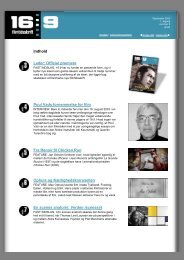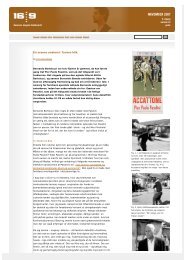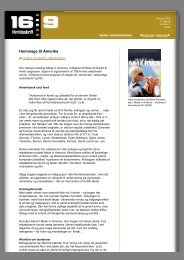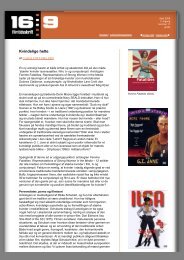Create successful ePaper yourself
Turn your PDF publications into a flip-book with our unique Google optimized e-Paper software.
gradually, is widely recognized as an American hero, and unsurprisingly<br />
films have been made, depicting and dramatizing his already dramatic<br />
life.<br />
Between Political Success and Personal Tragedy: Griffith’s<br />
Abraham Lincoln<br />
An early fictional account of Lincoln’s life is seen in D.W. Griffith’s often<br />
overlooked talkie Abraham Lincoln (1930), a film dealing with “Abe” as<br />
a sort of tragic hero who succeeds in freeing the slaves and bringing<br />
The Civil War to an end, but suffers great personal tragedies.<br />
In the very beginning of the film, Lincoln (Walter Huston) experiences<br />
a great loss, and as Lincoln comes to see his loved one, we see him in<br />
a grippingly personal scene, displaying his inner turmoil. Lincoln comes<br />
to see the young woman, who is desperately ill, and in a medium<br />
close-up (MCU) Lincoln is seen, trying to deal with the illness of his<br />
loved one and one particular line of dialogue: “Now, Abe, I must tell<br />
you the truth” (fig. 14).<br />
As he enters the room, he sees the young woman lying in her bed; he<br />
paces the floor, takes off his hat and kneels in front of her, before she<br />
– in a strongly melodramatic exchange of dialogue – reminds him to<br />
“be brave” (fig. 15).<br />
In this scene, like in many others from Griffith’s film, Lincoln is<br />
depicted as an emotional person, and his bravery is underlined in the<br />
dialogue, as it later is in his actions and speeches.<br />
The film, in a sense chronicling Lincoln’s life, moves toward a climax,<br />
and the main character is seen (in a number of long shots) pacing<br />
around, thinking of how to deliver his “Emancipation Proclamation” (fig.<br />
<strong>16</strong>). Naturally, the film ends in a tragedy, as Lincoln is assassinated in<br />
a theatre, thus creating a classically dualistic “tragedy – success”<br />
structure where political success and bravery are juxtaposed with<br />
personal turmoil and tragedy.<br />
The Dual Structure of Abraham Lincoln (1930, dir. D.W. Griffith)<br />
Griffith, who is widely known for his racist epic The Birth of a Nation<br />
(1915), shows a more humanistic quality in his political biopic about<br />
Abraham Lincoln, depicting its title character as a brave “Emersonian<br />
individual” and reminding us of the last stanza in Emerson’s poem “A<br />
Nation’s Strength” (1904):<br />
Brave men who work while others sleep<br />
Who dare while others fly<br />
They build a nation’s pillars deep<br />
And lift them to the sky.<br />
(Emerson 2003, p. 43).<br />
John Ford and the rise of Lincoln<br />
Griffith’s film shows us the rise of Abraham Lincoln, from “humble<br />
origins to becoming one of the greatest orators of his and any other<br />
age” (cf. Pickwick Group Limited), but also his inevitable and tragic<br />
fall.<br />
The 1939 film by John Ford, on the other hand, focuses solely on<br />
Lincoln’s ascendancy to become one of the key figures in American<br />
history and politics. In Ford’s film we follow Lincoln, convincingly<br />
played by Henry Ford, who leaves Kentucky to practice law, before<br />
going into politics.<br />
The “great humanist”, John Ford, sees his heroic protagonist rise to the<br />
top, not only figuratively but also literally, as Lincoln’s final words are,<br />
“I think I’ll go to the top of that hill” – followed by a low angle shot of<br />
Lincoln climbing to the top of a hill, accompanied by the astounding<br />
“Battle Hymn of the Republic” (fig. 17).<br />
“I’m Not a Crook”: Richard Nixon as a tragic hero?<br />
If Abraham Lincoln is one of the most prominent, iconic and popular<br />
figures in American history, Richard Nixon is undoubtedly one of the<br />
most criticized and “villain-like” characters in American history.<br />
From Strict Upbringing to National Disgrace: Nixon<br />
Fig. 14.<br />
Fig. 15.<br />
Fig. <strong>16</strong>.<br />
Fig. 17: Abraham Lincoln rises to the top in<br />
Ford’s political biopic, The Young Mr.<br />
Lincoln (1939), a film recognized by Pauline<br />
Kael as “one of John Ford’s most<br />
memorable films” (cf. Twentieth Century<br />
Fox 2005).<br />
Fig. 18.<br />
Fig. 19: Authentifying footage from the<br />
beginning of Ron Howard’s Frost/Nixon<br />
(2008).
















